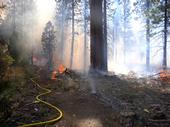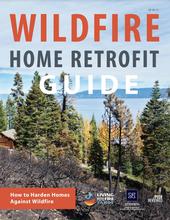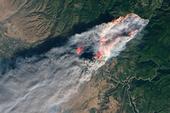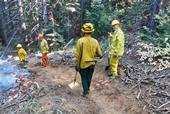- Author: Jeannette E. Warnert

The massive die-off of conifers in the Sierra Nevada between 2012 and 2018 was predictable and unprecedented. Sadly, it is also likely to happen again, said UC Cooperative Extension forestry advisor Susie Kocher.
To help landowners manage forests in a way that minimizes the risk of such catastrophic tree die-off and the threat of uncontrolled wildfire, Kocher and two colleagues produced a 20-page publication that summarizes current research on tree mortality and outlines actions that can be taken to make the forest more resilient. The publication, Mass Tree Mortality, Fuels, and Fire: A Guide for Sierra Nevada Forest Landowners, is...
- Author: Jeannette E. Warnert

A team of California and Nevada fire scientists have produced a booklet with step-by-step guidance on retrofitting an existing home to be more resilient to fire.
Susie Kocher, UC Cooperative Extension forestry and natural resources advisor and co-author of the new guide, said some homeowners feel powerless to protect their homes against California's increasing wildfire threat.
“I'm happy to tell them that's not true. There are specific actions that we can all take to reduce the likelihood of our homes being burned in wildfire,” said Kocher, who lives in a forested area near Lake Tahoe. “We need to educate ourselves on the details of home construction that...
- Author: Jeannette E. Warnert

Forestland owners can learn how to survey the trees on their property from four new videos produced by UC Cooperative Extension, setting them on a course for sustainable management of their forestland. The videos are available on the UC ANR YouTube channel (http://youtube.com/UCANR).
Learning the tools and techniques used for centuries by professional foresters and research scientists allows private forest owners to collect data that paints a picture of the land and trees' current condition.
“Whether it's managing to reduce wildfire, control invasive species, protect the nature beauty or maximize timber harvest, you need to know...
- Author: Jeannette E. Warnert

For millennia, fires periodically burned through California forests, thinning trees, reducing shrubbery and clearing out downed branches and debris. Without periodic fire, the forests became more dense, with spaces between large trees filling in with a thick carpet of duff, seedlings and shrubs.
As a result, today's forests are prone to more intense and damaging fires, like the Rim Fire, King Fire, and — most recently — the Camp Fire in Butte County. These fires are burning with unprecedented severity and speed, threatening large swaths of forest, towns, and even urban areas.
Using fire as part of forest management is not a new concept. Native Americans...
- Author: Susie Kocher
- Author: Rob York
- Author: Lenya Quinn-Davidson

The humble rake has been in the spotlight in recent weeks, and its role as a forest management tool ridiculed and scorned. However, most fire professionals believe rakes are a necessary part of saving California's forests.
Those who are familiar with fire are undoubtedly familiar with the McLeod, which is a standard firefighting tool and … it is essentially a rake (one side is a rake with coarse tines and the other side has a flat sharpened hoe). The McLeod was created in 1905 by a U.S. Forest Service ranger who wanted a single tool that could rake fire lines (with the teeth) and cut branches and roots (with the sharpened hoe edge). The McCleod is used to scrape fuels...



